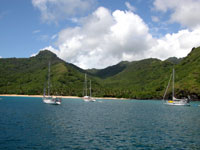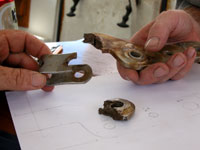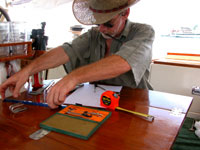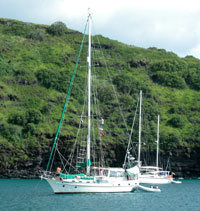| 2C Update #108
Île Tahuata
Baie Hanamoenoa
May 1-7
Hanamoenoa is a lovely, uninhabited, CALM anchorage on the west side of Île Tahuata. The hills embracing the anchorage are bright green, while at the head of the bay is a white sand beach, backed by waving coconut palms and lime trees. On the ridge above, wild horses are sometimes seen in silhouette. The guide books say this has been called one of the most beautiful anchorages in Polynesia ! I don't know about that--excepting the mist shrouded peak above, it is actually a bit reminiscent of the Virgin Islands in the green season. When we arrived here just before sunset, the anchorage was full of cruisers, about half of whom were friends from Mexico and the other half being boats who'd transited from Panama. We anchored at the back of the pack and got our first good night's sleep in a month!
 We had been driven out of Atuona without making contact with either the Navy base machine shop or the town welder, and indeed the conditions had been so rolly that Don had still not gotten up the mast to assess the damage to the rig. First thing the next morning Don went up in the bosun's chair to inspect the situation. We had been driven out of Atuona without making contact with either the Navy base machine shop or the town welder, and indeed the conditions had been so rolly that Don had still not gotten up the mast to assess the damage to the rig. First thing the next morning Don went up in the bosun's chair to inspect the situation.
What he found was scary. The fitting at the outer end of our port lower spreader where the upper cap shroud, the lower cap shroud and the lower end of the upper intermediate meet at a sort of Y-shaped plate had, as we'd guessed, the one ear where the upper intermediate attached completely broken off. The good news was the rest of the plate which essentially makes the principal support for the port side of the rig was sound. The bad news is that he found a badlycracked toggle on the other side we hadn't had a clue about!
What made these finds particularly upsetting was the fact that we were guilty of overlooking them before we left, hidden as these connections were under fancy leather spreader boots. Despite spending all of last winter fabricating and installing new chainplates to ensure a sound rig, despite having the rig tuned and looked at by two professionals, despite Don's personally checking the rig top to bottom for cracks, nobody ever got around to cutting off the spreader boots to look underneath them. It was an oversight that could have been disastrous. The fact that we came out of it with little more than some chipped paint on the mast and some days of anxiety owes more to luck and the CSY's renowned overbuilt rig design than anything. We are suitably chastened.

The very nice thing about any anchorage with this many boats is that there is assembled quite a bit of talent and material to make just about any repair a boat might need. On our second morning Michael of Djadarra , the rigger who had counseled us at sea, pulled in. He went up the rig to check over Don's conclusions and then he and Don dismantled the plate and brought it down. Michael made a technical drawing to transfer onto a stainless plate of the right dimensions that Greg of Billabong had had in his spares. Dennis of Bobulona had a die-grinder to cut the plate and Ralph of Ocean Girl contributed a reamer to make the largest of the four holes that had to be drilled. Two boats had metal-working experts to advise and counsel on the drilling of stainless, and Don himself did most of the actual work both in the T2's engine workshop and aloft in the rig. It took about two days (counting replacing the cracked toggle for which we had a spare), but the long and the short of it is Tackless II's rig is back 100%, all done by cruisers for cruisers.
 |
 |
Just to put all this in perspective, we are hardly the only boat in the fleet to have had a problem on the crossing. Indeed, although ours was potentially major, our prudence got us in with no actual damage. Another boat limped in a couple of days after us with his in-boom furling mainsail jammed, his engine overheating and his windlass motor not working. A third came in last night after making two-thirds of the trip with no autopilot or instruments. A half-dozen boats had blown out sails. Djadarra, the rigger's boat, took a huge sea aboard during some bad weather that shot gallons of sea water into the boat through a broken dorade vent and knocked the crew about hard enough to break some fingers and a nose! One of the first boats to take off from Puerto Vallarta lost their rudder about 600 miles out and had to be towed back into to Manzanillo by the Navy after all his efforts to jury rig a substitute failed. In the group that traveled about two weeks ahead of us, one boat had a problem with its in-mast furling, while another got water in its engine which took five days while underway to get cleaned out and going again. That same boat later suffered the ultimate indignity of having a whale spout into its open cabin. Yuck!
But those boats that were ahead of us (many of them in this anchorage) all had their problems repairs by the time we arrived and were hard about the business of snorkeling, diving and touring. It is the nature of cruising that once the bad stuff is over, it is out of mind. After the last pin went in on our rig, we, too, finally celebrated with our first snorkel. The water is warm, clear, blue and home to all sorts of differently-colored and patterned fish. Giant manta rays feed behind the boats every evening, and one morning we saw two four-foot yellowfin tuna chasing a shoal of silver fish only a boat length away! Now that the rain has finally cut itself back to one or two showers a day, it is truly a beautiful place. For a few days there, we weren't too sure! |